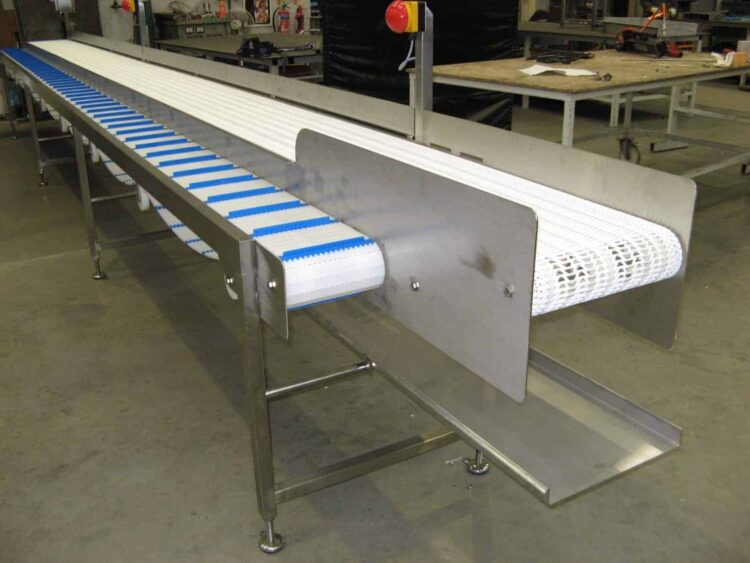Conveyor belts seamlessly facilitate the movement of goods and materials across various stages of production and distribution. From manufacturing plants to warehouses, airports to mining sites, conveyor belts are the best tools for efficiency and productivity.
Conveyor belts come in a variety of types to fulfill the operational demands of varied industries. Understanding these different types of conveyor belts is essential for optimizing processes and ensuring smooth operations across diverse industries.
In this blog post, we will discuss the different types of conveyor belts.
Wire Mesh Conveyors
Wire Mesh Conveyor belts are made of interlocking metal wires, have a unique design that makes it possible to move different materials efficiently.
The open construction of wire mesh belt conveyors is one of their primary benefits. Because of their easy-to-adjust airflow architecture, they are perfect for applications requiring drying or cooling. They are frequently employed in sectors including heat treatment, auto production, and food processing.
Another advantage of Wire Mesh Belt Conveyors is their capacity to manage large loads. High-weight items can be supported by the sturdy and solid surface created by the interlocking metal wires.
Additionally, Wire Mesh Belt Conveyors are simple to maintain and clean. Their open design lowers the possibility of contamination in the food processing and pharmaceutical industries by preventing debris from building up on the surface.
Modular Belt Conveyors
Modular belt conveyors are a popular option because of their distinctive design and adaptability in a variety of industries. These conveyors are made up of separate metal or plastic modules that are connected to create a continuous belt. They may be easily customized and modified due to their modular design, which makes them appropriate for a variety of applications.
The capacity of modular belt conveyors to manage intricate layouts and curves is one of its main features. Since the constituent modules are simply interchangeable or rearranged, they may be seamlessly integrated into current production lines or modified to meet evolving requirements. They are perfect for sectors with limited space or frequent reconfiguration requirements because of their adaptability.
Cleated Belt Conveyors
A type of conveyor system called a cleated belt conveyor uses elevated areas on the belt surface called cleats to keep objects from sliding off while being transported. These cleats are usually equally distributed along the length of the belt and can be made of a variety of materials, including plastic or rubber. Conveyor belt manufacture design cleated belt conveyors to withstand sharp drops and inclines is one of its key benefits. The material being moved is kept firmly in place even when going up or down an incline, thanks to the studs’ additional traction.
Apart from their capacity to manage inclinations, cleated belt conveyors are frequently employed for the purpose of sorting and dividing goods.
Inclined Belt Conveyors
Belt Slope One kind of conveyor system used to move things along an incline or drop is the conveyor. The flat belt on these conveyors has raised edges or studs to help stop objects from slipping down the incline. The ability of inclined belt conveyors to transfer items vertically makes efficient transportation possible even in confined locations, which is one of its key benefits. This makes them perfect for tasks like shifting products between floors of a building or loading and unloading lorries.
The adaptability of inclined belt conveyors is an additional advantage. They can be used to move a variety of items, such as packed goods, loose bulk materials, and even fragile items that need to be handled carefully.
Roller Belt Conveyors
One standard conveyor belt system utilized in many different industries is the roller belt conveyor. These conveyors, as their name implies, use rollers to assist in moving objects along the belt. The conveyor’s rollers, which are positioned at regular intervals throughout its length, revolve to move the goods forward.
Roller belt conveyors’ ease of handling large loads is one of their main benefits. They are perfect for moving big, heavy objects like pallets or crates because of their robust design and long-lasting construction. Because of this, roller belt conveyors are frequently seen in manufacturing facilities, warehouses, and distribution centers.
Please remember that every company is different and has particular needs and demands when it comes to conveying systems. Seeking advice from professionals in this area who can customize recommendations for your sector and business processes is crucial. Also, bear in mind that you can also consider switching to clean in place equipment along with the conveyor belts in order to increase efficiency and reduce human error.
Are you seeking reliability and durability in conveyor belts? Look no further than Wire Belt, where you’ll find robust solutions designed to withstand the rigors of industrial environments.

